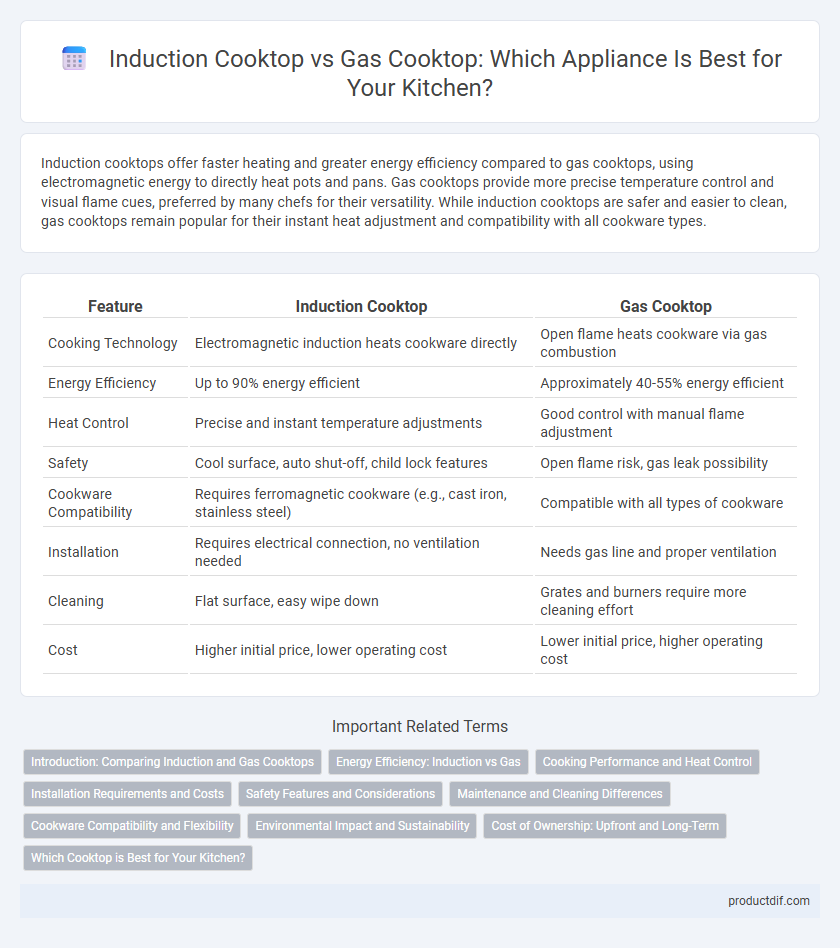Induction cooktops offer faster heating and greater energy efficiency compared to gas cooktops, using electromagnetic energy to directly heat pots and pans. Gas cooktops provide more precise temperature control and visual flame cues, preferred by many chefs for their versatility. While induction cooktops are safer and easier to clean, gas cooktops remain popular for their instant heat adjustment and compatibility with all cookware types.
Table of Comparison
| Feature | Induction Cooktop | Gas Cooktop |
|---|---|---|
| Cooking Technology | Electromagnetic induction heats cookware directly | Open flame heats cookware via gas combustion |
| Energy Efficiency | Up to 90% energy efficient | Approximately 40-55% energy efficient |
| Heat Control | Precise and instant temperature adjustments | Good control with manual flame adjustment |
| Safety | Cool surface, auto shut-off, child lock features | Open flame risk, gas leak possibility |
| Cookware Compatibility | Requires ferromagnetic cookware (e.g., cast iron, stainless steel) | Compatible with all types of cookware |
| Installation | Requires electrical connection, no ventilation needed | Needs gas line and proper ventilation |
| Cleaning | Flat surface, easy wipe down | Grates and burners require more cleaning effort |
| Cost | Higher initial price, lower operating cost | Lower initial price, higher operating cost |
Introduction: Comparing Induction and Gas Cooktops
Induction cooktops use electromagnetic fields to directly heat pots and pans, offering precise temperature control and faster cooking times compared to traditional gas cooktops. Gas cooktops rely on open flames fueled by natural gas or propane, providing visible heat and instant flame adjustment popular among professional chefs. Key differences include energy efficiency, safety features, and the type of cookware required, making the choice dependent on cooking style and kitchen setup.
Energy Efficiency: Induction vs Gas
Induction cooktops use electromagnetic energy to directly heat pots and pans, achieving energy efficiency rates of about 84%, compared to gas cooktops, which convert only approximately 40-55% of their energy into cooking heat. This higher efficiency in induction cooking reduces wasted heat and lowers overall energy consumption, leading to cost savings and a smaller environmental footprint. Gas cooktops emit more heat into the kitchen environment, further reducing efficiency and increasing cooling costs.
Cooking Performance and Heat Control
Induction cooktops offer precise temperature control with rapid heat adjustments, ensuring even cooking and minimizing energy waste. Gas cooktops provide immediate visual heat control and high-temperature performance, favored for quick sauteing and charring. Both appliances enhance cooking performance, but induction excels in consistent heat distribution while gas cooktops deliver traditional flame-based control.
Installation Requirements and Costs
Induction cooktops require a stable electrical supply with a dedicated circuit, typically 220-240 volts, and professional installation to ensure safety and optimal performance, often leading to higher upfront costs compared to gas cooktops. Gas cooktops need proper gas line connections and ventilation systems, which can increase installation complexity and expenses, especially if gas piping is not already in place. Overall, induction units have higher initial electrical installation costs, while gas cooktops may incur extra costs for gas line setup and venting adjustments.
Safety Features and Considerations
Induction cooktops use electromagnetic fields to heat cookware directly, reducing the risk of burns and fire hazards compared to gas cooktops, which rely on open flames. Induction models include automatic shut-off features, child locks, and surface cooling indicators, enhancing kitchen safety significantly. Gas cooktops require proper ventilation and frequent maintenance to prevent gas leaks and accidental fires, making safety considerations critical in their operation.
Maintenance and Cleaning Differences
Induction cooktops require minimal maintenance due to their smooth glass surface, which resists spills and can be easily wiped clean with a soft cloth. Gas cooktops need regular cleaning of burner grates and gas ports to prevent clogging and uneven flame distribution. Residue buildup on gas cooktops demands more frequent and detailed cleaning to maintain optimal performance and safety.
Cookware Compatibility and Flexibility
Induction cooktops require magnetic cookware such as cast iron or stainless steel to function efficiently, limiting compatibility with glass, aluminum, or copper pots unless they have a magnetic base. Gas cooktops offer greater flexibility, accommodating virtually any type of cookware regardless of its material or magnetic properties. This makes gas stoves a more versatile choice for diverse cooking techniques and cookware collections.
Environmental Impact and Sustainability
Induction cooktops offer significantly lower carbon emissions compared to gas cooktops, as they rely on electricity that can be sourced from renewable energy. Gas cooktops burn fossil fuels, releasing methane and carbon dioxide, contributing to indoor air pollution and greenhouse gas emissions. Energy efficiency of induction cooktops exceeds 80%, reducing overall energy consumption and supporting sustainable kitchen appliance choices.
Cost of Ownership: Upfront and Long-Term
Induction cooktops generally have a higher upfront cost, ranging from $500 to $1,500, compared to gas cooktops, which typically cost between $300 and $1,000. Long-term expenses favor induction due to its energy efficiency, using up to 90% of energy compared to gas's 40-55%, resulting in lower utility bills. Maintenance costs for induction units are usually lower since they contain fewer mechanical parts and no gas lines, reducing repair frequency and associated expenses.
Which Cooktop is Best for Your Kitchen?
Induction cooktops offer precise temperature control, faster heating, and enhanced energy efficiency, making them ideal for modern kitchens focused on safety and speed. Gas cooktops provide immediate flame control and compatibility with all cookware types, preferred by professional chefs and those valuing traditional cooking methods. Choosing the best cooktop depends on your cooking style, kitchen ventilation, and energy preferences.
Induction Cooktop vs Gas Cooktop Infographic

 productdif.com
productdif.com